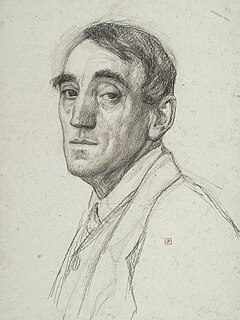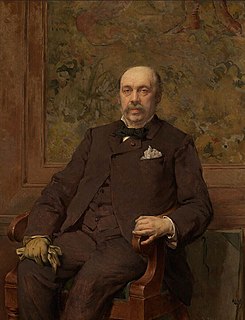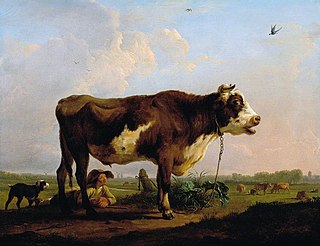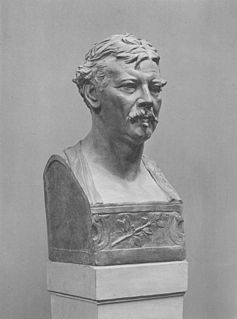
Jean Baptiste Discart (5 October 1855, Modena - 1 January 1940, Paris) was an Italian-born painter; known primarily for his portraits and Orientalist scenes. He worked mainly in France and the Netherlands, and came to be identified as French.

Jean Baptiste Discart (5 October 1855, Modena - 1 January 1940, Paris) was an Italian-born painter; known primarily for his portraits and Orientalist scenes. He worked mainly in France and the Netherlands, and came to be identified as French.
His father, Francesco Ferdinando Discart (1819-1893), worked at the court of Francis V, Duke of Modena. After graduating from the gymnasium, in 1869, he enrolled at the Academy of Fine Arts Vienna, aged only fourteen. He would study there almost continuously until 1880. His primary professors were Leopold Karl Müller and Anselm Feuerbach, who had the most influence on his style. He refused to continue his studies after Feuerbach's death. [1]
Around 1880/81, he settled in Paris, joining some of his fellow students from the Vienna Academy. It was there that he first developed an interest in Orientalism, and most likely created his first works in that genre in Tangiers. He later visited Morocco, and may have been to other parts of North Africa, although this is not well-documented. His visits there continued through 1920. Unlike many other Orientalists, his works were focused on daily life and its minutiae, rather than cityscapes, landscapes and harems. Most are very detailed. He probably created some paintings from photographs. [2] [3] [4]
From around 1895, he painted portraits in the Netherlands. His subjects mostly came from noble families, such as the Van Lyndens, the Van Limburg-Stirums, the Van Tuylls, the Van Heemstras and the Van Heeckerens. In 1909, he created a large portrait of King Albert I of Belgium, on the occasion of his ascension to the throne. His last known portraits, pastels of the Van Lyndens, were made in 1929. Most of them are in private collections. [5]
He died at his home in Paris in 1940.

Christiaan Karel Appel was a Dutch painter, sculptor, and poet. He started painting at the age of fourteen and studied at the Rijksakademie in Amsterdam in the 1940s. He was one of the founders of the avant-garde movement CoBrA in 1948. He was also an avid sculptor and has had works featured in MoMA and other museums worldwide.

Adolphe Joseph Thomas Monticelli was a French painter of the generation preceding the Impressionists.

Théophile "Théo" van Rysselberghe was a Belgian neo-impressionist painter, who played a pivotal role in the European art scene at the turn of the twentieth century.

Charles Angrand was a French artist who gained renown for his Neo-Impressionist paintings and drawings. He was an important member of the Parisian avant-garde art scene in the late 1880s and early 1890s.

Jean-Étienne Liotard was a Swiss painter, art connoisseur and dealer. He is best known for his portraits in pastel, and for the works from his stay in Turkey. A Huguenot of French origin and citizen of the Republic of Geneva, he was born and died in Geneva, but spent most of his career in stays in the capitals of Europe, where his portraits were much in demand. He worked in Rome, Istanbul, Paris, Vienna, London and other cities.

Jean-François Portaels or Jan Portaels was a Belgian painter of genre scenes, biblical stories, landscapes, portraits and orientalist subjects. He was also a teacher and director of the Academy of Fine Arts of Ghent and the Académie Royale des Beaux-Arts in Brussels. He is regarded as the founder of the Belgian Orientalist school. He was praised in his time as the premier painter of 'everyday elegance and feminine grace'. Through his art, teaching and his leadership of the Académie Royale in Brussels he exerted an important influence on the next generation of Belgian artists, including his pupil Théo van Rysselberghe.
Justus Sustermans, Joost Sustermans or Suttermans, his given name Italianised to Giusto, was a Flemish painter and draughtsman who is mainly known for his portraits. He also painted history and genre paintings, still lifes and animals.

Jean Baptiste Vanmour or Van Mour was a Flemish-French painter, remembered for his detailed portrayal of life in the Ottoman Empire during the Tulip Era and the rule of Sultan Ahmed III.

Goupil & Cie is an international auction house and merchant of contemporary art and collectibles. Jean-Baptiste Adophe Goupil founded Goupil & Cie in 1850. Goupil & Cie became a leading art dealership in 19th-century France, with its headquarters in Paris. Step by step, Goupil established a worldwide trade in fine art reproductions of paintings and sculptures, with a network of branches and agents in London and other major art capitals across Continental Europe as well as in New York City and Australia. LesAteliers Photographiques, their workshop north of Paris, in Asnières, was instrumental in their expansion from 1869. The leading figure of Goupil & Cie was Jean-Baptiste Adolphe Goupil (1806–1893). His daughter Marie married the French artist Jean-Léon Gérôme.
Charles-Émile-Callande de Champmartin was a French painter, noted for his Orientalist works.

Théodore Jacques Ralli or Theodorus Rallis was a Greek painter, watercolourist and draughtsman, who spent most of his working life in France and Egypt.

Balthasar Paul Ommeganck (1755–1826) was a Flemish painter of landscapes and animals active in Antwerp. Through his work and his role as an art teacher and founder of art institutions he gave an important impetus to the revitalization of landscape painting in the Low Countries.

Leopold Carl Müller was an Austrian genre painter noted for his Orientalist works.

Jacobus Josephus Eeckhout or Jacques Joseph Eeckhout was a Flemish painter, sculptor, pastellist, water-colourist and lithographer and a Director of the Royal Academy of Art in The Hague.

Pieter Faes or Peeter Faes was a Flemish painter of still lifes of flowers and fruit. He worked in a decorative style close to that of Jan van Huysum.

Alexis Grimou, also Grimoult or Grimoux (1678–1733) was a French portrait painter. He worked for an elite clientele and was called the French Rembrandt as he introduced the Northern European style of portrait painting in France. Many of his intimate portraits at half-lengths were influential on the development of 18th-century portrait painting in France. Portrait painters such as Jean-Honoré Fragonard and Jean-Baptiste Greuze were influenced by his work.

Jean Raymond Hippolyte Lazerges (1817–1887) was a French painter, and composer of mélodies and chansons.

Ludwig Deutsch (1855–1935) was an Austrian painter who settled in Paris and became a noted Orientalist artist.

Jan Baptist Morel or Jean Baptiste Morel was a Flemish still life painter who specialized in flower pieces and garlands. He was a successful artist who worked in Antwerp and Brussels.

Ernest Slingeneyer, Ernest Isidore Hubert Slingeneyer or Ernst Slingeneyer was a Belgian painter of history paintings, portraits, genre scenes and the occasional landscape. Slingeneyer is regarded as one of the last representatives of Romanticism in Belgian painting and of Academism in Romanticism in Belgian art. In his later career he was one of the leading representatives of Orientalism in Belgium. An excellent portraitist, Slingeneyer made portraits of historical figures as well as of well-known figures from his time. Slingeneyer was also a politician and was a member of the Belgian Chamber of Representatives for the Independists of Brussels, a coalition of personalities bound by their opposition to the Radicalist liberals. As a politician he promoted Academic art and agitated against new artistic currents as promoted by, amongst others, the Société Libre des Beaux-Arts in Brussels.
| Wikimedia Commons has media related to Jean Discart . |